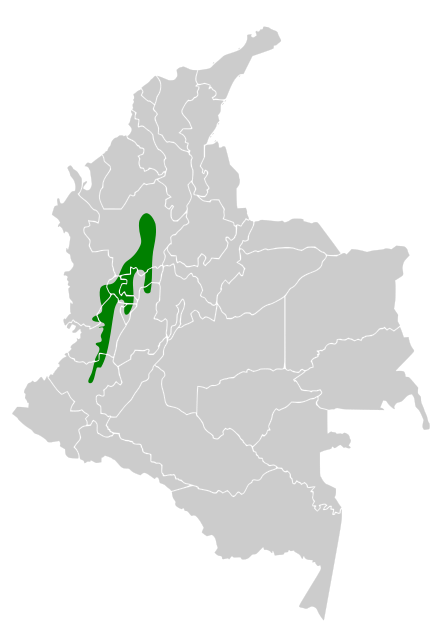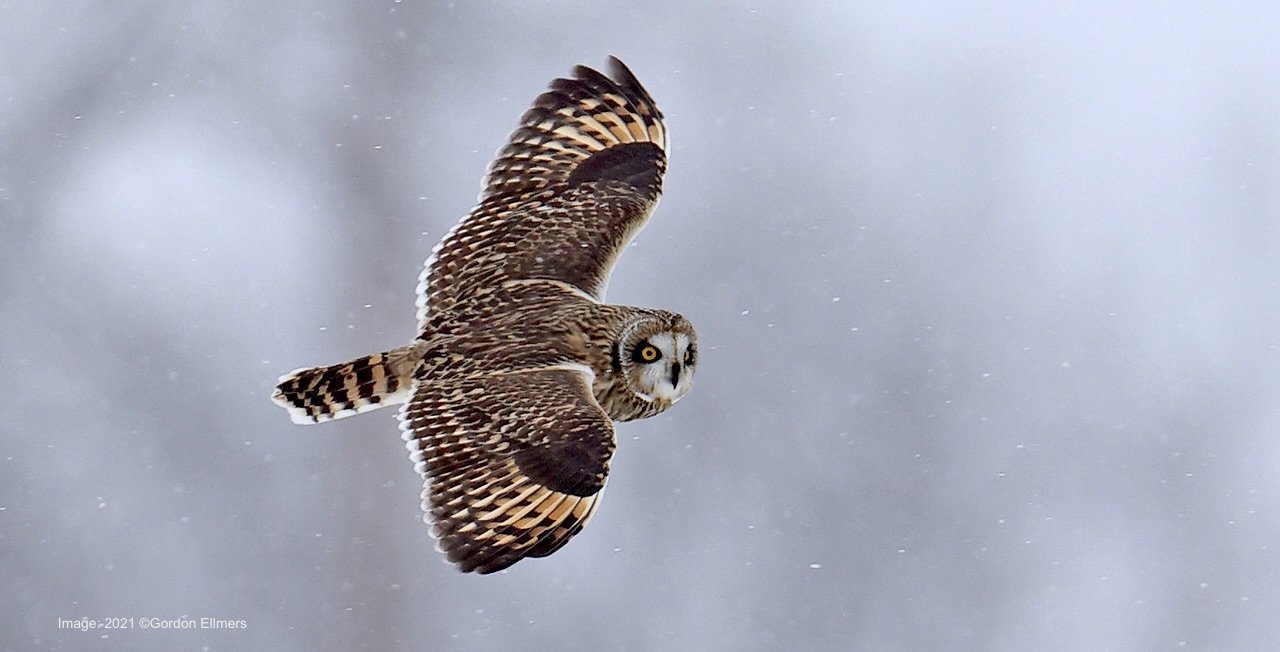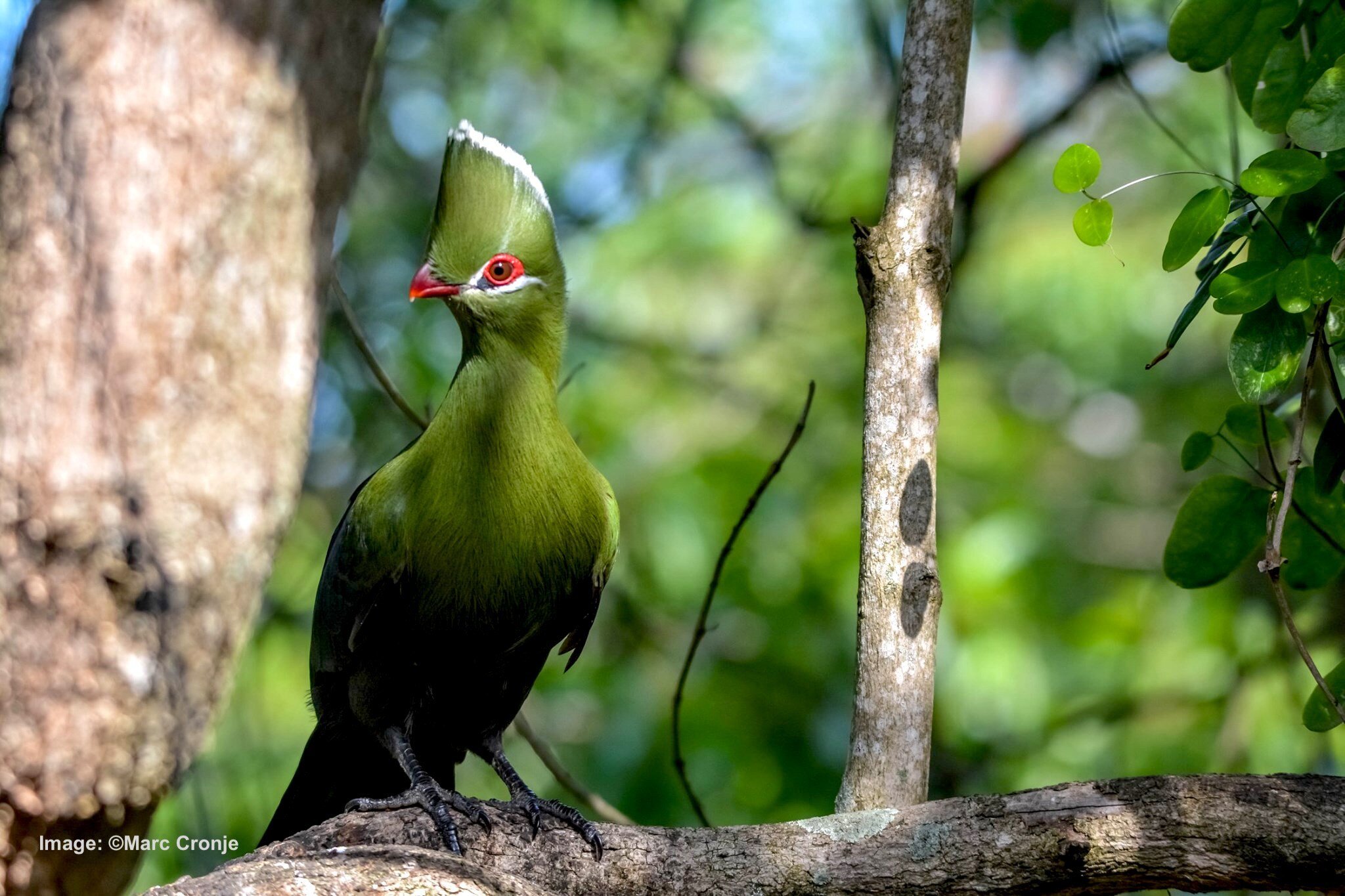10 Beautiful Birds You Can ONLY See in Colombia
The neon-bright Multi-colored tanager is one of Colombia’s 78 endemic bird species, many only found only in a single tiny “island” of habitat. Colombia is a birder’s paradise. Image: ©Jorman Esteban Berrio
Colombia! Long before I’d first glimpsed its cloud-topped mountains, walked its deep, lush rainforests, or experienced the extraordinary sound of dozens of hummingbirds gathered to sip nectar, long before my first trip in 2021, I’d heard Colombia was beautiful. But the reality of Colombia’s wild places, from its shorelines to the páramos to the Andes massive, is more than beautiful - Colombia is magic.
Roberta Kravette, editor and travel professional
5 Birding Fast Facts of Colombia
Colombia is #1 in the world for its number of bird species, according to Mongabay and is the third (or second depending whose list you reading) most biodiverse country on the planet.
Colombia's record-breaking 1900 species is nearly 20% of the world's total avian species, according to Audubon!
This remarkable number includes 78 endemics,
87 threatened species, and
200 migratory species – many of whom many of whom, for example yellow warblers and cerulean warblers - make their summer residence in my home state of New York, over 2300 miles away!
Much of Colombia’s Andes, Amazon, páramo and other biorich eco-regions have yet to be fully studied so we don’t know much about may of this birds except that you can only see there here! Let’s go!
But is Colombia Safe? Yes!
I stayed with the Molina family on their El Encanto Nature Reserve (Huila department, southern Colombia) It is one of the plantations adding biodiversity preservation and eco-tourism into their business model. Their specialty: BIRDS! That’s Michael Molina (left world-class birder and guide) with avian photographer Robin A. Mettler, Michael’s his sister is the (fabulous) cook and Mr and Mrs Molina who run the lodge and coffee plantation. Image: Facebook, El Encanto Nature Reserve.
✓TRIP TIPS
Where: Colombia, S.A.
When: Driest time: Dec., Jan. and Feb.
What: Endemic Birds
Why: They only exist here!
There is no hiding that Colombia’s history weighs heavily on the mind, however, that fraught past is just that - past. I can report from unforgettable personal experiences that today's Colombia is a peaceful, friendly, and welcoming country. The government's message of economic progress with the protection of its unique environment is evident in the conversation and pride of its people. "Biodiversity is our gold," is a mantra I heard over and over from folks from all walks of life.
Many people, including farmers and plantation owners, take environmental protection personally. With the support of the government, some are establishing reserves and sanctuaries on their properties and incorporating eco or agri-tourism into their business models. Researchers are flocking to Colombia to study birds, plants, herbivores, etc., and taking time to teach the landowners about their unique environments.
I've had the pleasure of experiencing a few of these new enterprises (including El Encanto Nature Reserve, which I love); they are a deep dive into this fascinating country's diverse cultures and biologically rich nature, and they help sustainably preserve both. I love them - but let's get to the birds!
10 of My Favorite Endemic Birds of Colombia
Below are a few of my favorite of Colombia’s 78 endemic bird species - well, this week’s favorites. Stay tuned, my favorite changes with each sighting! Use the descriptions as a fast general overview; there is much more to learn! And remember to add them to eBird as you build your life list!
#1. Buffy Helmetcrest Hummingbird
Oxypogon stuebeli
IUCN listed: Vulnerable
Population: ~1000 individuals
Central Andes, grasslands (páramo)
Elevation: 10,500 -16,400ft /~3000-5200m
Buffy helmetcrest hummingbird.
Range Map: Wikipedia
I love all hummingbirds, but Buffy helmetcrest hummingbird's short bill, larger size, wonderfully green and blue "beard-like" gorget, and distinctive black and buff head and crest make this a bird worth searching for! And like many of Colombia's endemics, you'll look for this hummer in a very limited range.
Although the most widespread of its genus, the Buffy helmetcrest can only be found in a tiny region of Colombia's eastern Andes in an ecosystem called the páramo (a rare and vital ecosystem found in only three countries on the planet.)
Where to Look for The Buffy Helmetcreat Hummingbird:
To find the Buffy Helmetcrest, travel about 60 miles south of Bogota and into the páramo at the Los Nevados National Park near the Nevado del Ruiz volcano in Colombia's central Andes. Once there, the search begins. Look carefully; their entire population may be only 1000 birds.
Tips for Identifying the Buffy Helmetcrest:
At almost 5 inches / 12.7 cm, the Buffy helmetcrest is "large" for a hummingbird and has a short beak. Look for their "helmet and beard" - but watch them feed - unlike most other hummers, they cling to flowers upright rather than hovering in the air. (Image Thanks to Robin A. Mettler)
#2. Multi-Colored Tanager
Chlorochyrysa nitidissima
IUCN listed:: Threatened
Western and Central Andes, subtropical forests
Elevations: 4265-7218ft / 1300-2200m
Multy-colored Tanager. Range map: Wikipedia
Its Latin name tells the story of the stunning Multi-colored tanager. Chlorochyrysa comes from the words for green and gold, and nitidissima means "most brilliant." It certainly is! This neon-colored beauty takes your breath away.
Where to Look for the Multi-colored Tanager
It was a formerly common species in its restricted range, but multi-colored tanagers are declining, still they have been recorded at Quindio (Ucumari Regional Park, Risaralda - do not confuse the Park with the zoo of the same name) and also the Valle del Cauca. You may find them near Cali and north in the unprotected Pichinde Valley in the west Andes, too.
Tips for Identifying the Multi-colored Tanager.
At only 4.75 in / 12 cm, this rare little beauty's multitude of neon colors make it stand out in a country with many gorgeous birds. Look for the male's sunny yellow face with dark chestnut patches on each side of its neck. It has a yellow mantle, gleaming green nape, wings, tail, and bright turquoise rump. Its underparts are bright blue with a black median breast and belly. The female's coloring is similar but softer and duller, and females don't have the yellow mantle or black underparts. (Image Thanks to Robin A. Mettler)
#3. Yellow-Eared Parrot
Ognorhynchus icterotis
IUCN listed: Vulnerable
Central Andes, Scattered habitats only where
there are stands of wax palms
Elevation: 3940-9840ft / 1200-3000m
Yellow-eared parrot range map: Wikipedia
Once relatively abundant in its range, the Yellow-eared parrot is extremely rare. These parrots wander rather than migrate; they search for the fewer and fewer existing wax palms they require for food and nesting.
Where to Look for the Yellow-eared Parrot
Historically, the Yellow-cheeked parrot was common in all three of Colombia's Andean ranges, but its numbers suffered a catastrophic collapse due to the almost total clearing of wax palm (Ceroxylon) - ironically, Colombia's national tree and the tree that their life cycle revolves around.
Their habitat is now highly fragmented and restricted to a few scattered localities of central Colombia. Although once found in Ecuador, it is probably extinct there. It likes humid montane forests and partially cleared areas where it can find its wax palms. The Yellow-cheeked parrots range is now highly fragmented, and they may be nomadic, seasonally wandering in search of food (wax palm nuts, some fruit.) The Yellow-eared Parrot Reserve in Jardin, Antioquia is a perfect place to look.
Tips for Identifying the Yellow-eared Parrots
These large ( 16.5 inch / 42 cm) green parrots have a bright yellow forehead, face and cheek. Its breast is a light yellow-green, and its long tail is green. Hint: Get up early and listen for them. They roost communally and just when the sun begins to come up they make a lot of noise as they fly out to the feeding sites.
#4. White-tailed Starfrontlet Hummingbird
Coeligena phalerata
IUCN listed: Near-Threatened
Sierra Nevada de Santa Marta Mountains, Interior (m) and borders (f) of wet montane forest
Elevation: 4595-12,140ft / 1400-3700
White-tailed Starfrontlet Himmingbird Range Map by Wikipedia.
Only the male of the species has the striking snow-white tail and sparkling coloring that gives the White-tailed starfrontlet its name; the females' color is far more subdued, but they have their territorial natures in common.
Where to Look for the White-tailed Starfrontlet Hummingbird:
The Sierra Nevada de Santa Marta, the world’s tallest coastal mountain, has been called “The Heart of the World.” It is an isolated massif in northwestern Colombia and home to about 70 bird species only found there - including the White-tailed starfrontlet. While many hummingbirds adjust to non-natural habitats, the White-tailed starfrontlet do not seem to or like any habitat disturbance.
They seek out the humid, wet montane forests – although males and females have different ideas of the locations. Look for the males in the forest interior, while the females will be found mainly on the forest fringes. They feed on fuchsia, bromeliads, bananas, other flowers, and arthropods.
Tips for Identifying the White-tailed Starfrontlet
The male white-tailed starfrontlet is a striking bird with a glistening turquoise crown and a small white postocular spot. Its underparts are emerald green, highlighted by a blue throat patch, and the young bird's white tail is bronze-tipped, but the color disappears with maturity. The female has shining green upper parts and is cinnamon – or rufus - color below. Both sexes have long, straight bills, but the females are longer. (Image Thanks to Robin A. Mettler)
#5 Santa Marta Screech Owl.
Megascops gilesi
IUCN listed: Vulnerable
Sierra Nevada de Santa Marta Mountains, humid montane forest
Elevation: 5600-8200ft /1800-2500m
Santa Marta Screech Owl range map by Wikipedia
The elusive Santa Marta screech owl is another bird of the super bio-rich Santa Marta mountains. Researchers have just a single specimen collected in 1919 to study! But, in the 1990s, its call was recorded, and finally, in 2007, researchers discovered it to be a new species! Since then, we have had many sightings and images, but we still know little about this owl.
Where to Look For the Santa Marta Screech Owl
All recordings of the Santa Marta Screech-owl are from the Sierra Nevada de Santa Marta along the San Lorenzo ridge in the northernmost part of Colombia. The owls may be confined to the humid forests at about 1,800 to 2,500m – or they may be higher. Researchers know extremely little about this bird. Calling all citizen scientists and birders: keep looking – and report what you see!
✍︎ Editor’s Note: Colombia’s Indigenous people initiated the Sierra Nevada de Santa Maria National Park expansion - widening protection for Santa Marta Screech Owls and many other species
Tips for identifying the Santa Marta Screech Owl
Look for the big yellow eyes of this medium-sized owl; it has a faint eyebrow that is buffy-white, as is its facial disc and throat and breast. The breast has narrow black-brown streaks and bars into its belly. Its brown crown and back are barred. Its tail is blackish-brown with nine buffy-grey bars bordered on each side by a black bar.
Because there is only a single specimen caught for study, its size range and other details are in question; however, photographs have suggested that they have both a reddish and grey morph.
#6 Yellow-headed Brushfinch
Atlapetes Latinuchous
IUCN listed: Endangered.
Est. Population: fewer than 1000
Central Andes and Western slope of Western Andes
brush and undergrowth
Elevation: 6530- 8500ft / 1900-2440m
Yellow-headed Brushfinch range map: Wikipedia
Until 1967, when researchers captured another bird in a new site, only three specimens told the story of the unusual and rare Yellow-headed Brushfinch. Today, their population is estimated to be fewer than 1000 individuals, according to the Cornell Lab of Ornithology.
☞A Note from Nature Photographer Robin Alexander Mettler
I went out looking … every morning during several weeks last year trying to take a photograph that does it justice. But - doing honor to its name, it never really came out of the brush … One morning , coming back from daily round, I glanced something sitting on a branch just next to the trail, perched out in the open! It gave me a full 10 minutes … posing and seemingly not minding my presence at all!
Where to Look for Yellow-breasted Brushfinch
For years, experts thought Yellow-breasted brushfinch were only in the Toche Valley, Tolima. However, they were recently seen in the Central Andes range, Selva de Florencia National Park, Caldas department (look for frogs and monkeys, too) , south to Inzá, Cauca department, and the Western Andes range.
They like the brush near cleared areas or undergrowth in wet montane forests and some borders of plantations and orchards where they forage for small fruit, insects, and seeds. Although its range is now understood to be greater than once thought, including Las Hermosas, Los Nevados, Nevado del Huila, and Puracé National Parks, continued habitat loss exasperates their decreasing numbers.
Tips for Identifying the Yellow-breasted Brushfinch
Look for a yellow head with an olive-colored grizzling head that can appear large-ish and round due to the crown feathers that often rise. Its tail is graduated, and its curved bill appears short and blunt. Its upper parts are olive, including the upper wing coverts with blackish flight and tail feathers. But its throat to under the tail is bright yellow. (Image Thanks to Robin A. Mettler)
#7 Santa Marta Woodstar (f)
Chaetocercus astreans
IUCN listed: Least Concern (not much is known)
Sierra Nevada de Santa Marta Mountains,
montane forest edges, plantations
Elevation: 2690-6562ft / 820 -2000m
Santa Marta Woodstar, range map: Wikipedia
Congratulate yourself when you find this bird! The tiny ( 2.54in /7c) Santa Marta woodstar hummingbird lives only in the Santa Marta Mountains, and is the region's only woodstar. It usually keeps to the safety of the cloud forest, but on rare, lucky occasions, you may spot the tiny bee-like hummer nearly at sea level.
These hummers rarely visit feeders, but if you look to the top of the tallest trees, you may see one sitting on bare branches. The male and female have the woodstars' typical bright white rump spots, but the female has a tawny belly above her bronzy-green back and a black mask. The male's upper parts are a bright bluish color with a sparkling magenta throat patch bordered in white.
Where to Look for Santa Mart Woodstar:
The northwestern corner of Colombia, in the Minca area, Pica Cristobal Colon, and San Sabastian Rabago areas are the best. And be sure to visit the El Dorado Nature Reserve. We know very little about this beauty; its breeding habits are a mystery, as are its population numbers, but they seem locally common within their restricted range. Have you seen it? Take notes and let us know!
#8 Bogota Rail
Rallus semiplumbeaus
IUCN listed: Vulnerable
Estimated Population: 3700 mature adults
East Andes’ Ubate-Bogota Plateau
Elevation: 8200-11,811ft / 2500-3600m
Bogota Rail range map: Wikipedia
Go early and stand quietly when in the Bogota rail territory. The Bogota rail’s solitary early morning "hunt" for invertebrates, frogs, tadpoles, and fish includes fun behaviors to watch. They run, swim, dart, and jump. But after hunting for food, they may 'evaporate' back into the vegetation and hide. It is only when you get too near to them that the birds flush, flying a short distance and then disappearing again amongst the green.
Where to look for the Bogota Rail
The only known place to look for this cousin of the Virginia rail is the Ubate-Bogota plateau in the Cundinamarca and Boyaca departments in Colombia's East Andes. Laguna Chingaza in the Chingaza National Park may be a good place to start. Look for them in flooded grassy areas and páramo marshes along the edges of reed beds and rushes, and in shallow water. Sometimes they might be found in reed-filled ditches or shallows with thick vegetation and regenerating burned areas in open rush-filled fields. According to the Cornell Lab of Ornithology, there may be only 3700 mature individuals in the wild. Look for them at 2500 – 3600m and occasionally at 2100 and 4,000m.
Tips for Identifying the Bogota Rail
Its long red bill, reddish legs, feet, and "plumbeous" grey head, breast, and upper belly make this rail a little beauty. Their upper parts are brownish and streaked. The sexes are alike.
# 9 Tolima Blossomcrown
Hummingbird
Anthocephala berlepschi
IUCN listed: Vulnerable
Central Andes, eastern slope
Humid forest and forest edges
Elevation 3938-8202ft / 1200-2500m
Tolima Blossomcrown Hummingbird range map, Wilipedia.
We know very little about the Tolima Blossomcrown hummingbird; we have no breeding, diet, or life-cycle data, and known behavioral data is minimal. What we do know is this: 1) it is probably related to the Santa Marta Blossomcrown, and 2) it is a lovely bird! When you find it – take notes, snap a picture, log it on e-Bird - We are all Citizen Scientists!
Where to Look for the Tolima Blossomcrown
These hummers seem to like humid, older, second-growth forests and forest edges. Look for these highly range-restricted birds in Parque Nacional Natural Los Nevados and Parque Nacional Natural Cueva de los Guácharos (UNESCO bio-reserve). And look for them at the El Encanto Reserve, one of my favorite places on earth! Elevation: 1200-2500m
Tips for Identifying the Tolima Blossomcrown
The Tolima Blossomcrown is about 3.3 inches / 8.4 cm with a straight black bill. The males have shining green upperparts with a perky crown of buffy-white (forecrown) and rufus chestnut (hindcrown). Males and females have the postocular white spot, and their underparts are gray-buff. The females' coloring is similar to the males', but their crown is more brownish. (Image Thanks to Robin A. Mettler)
# 10 Black-cheeked Mountain Tanager
Anisognathus melaogenys
IUCN listed: Least concern
Sierra Nevada de Santa Marta Mountains
Elevation: 5250-10,500ft /1600-3200m
Black-cheeked mountain tanager range map. Wikipedia
Where to Look for the Black-Cheek Mountain Tanagers
Black-cheeked mountain tanagers, also known as the Santa Marta tanagers are, not surprisingly, another species restricted to the Santa Marta mountains, where they prefer the forest borders and second-growth woodlands. Look for them at elevations between 1500 – 3200 m; however, some may wander down to 1200m during the wet season. Like other tanagers, they enjoy being in mixed flocks – fun for us. Black-cheeked tanagers are fruit eaters.
Tips for Identifying the Black-cheeked Mountain Tanager
Look for the large black cheek patches punctuated by a tiny yellow "teardrop" surrounded by their blue crown and upper parts. Their striking underparts are yellow to yellow-orange. This beautiful tanager is readily found in its limited range mostly due to its ability to adapt to second growth and edge habitat. Black-cheek mountain tanagers tends to travel in pairs and join up with small groups of about six individuals to forage for small fruits and possibly some insects, too, but that food preference is suspected, not certain. (Image Thanks to Robin A. Mettler)
Colombia is a Do-Not-Miss Birding Destination
These are just few of the 1900+ birds in Colombia. You could spend years devoted to seeing all of Colombia’s birds and still have more to see, and that does not consider the primates, herbivores and others that you will enjoy along the way. And one of the best things about trying to find all of Colombia’s birds is that you’ll also be enjoying the fascinating cultures, fabulous cuisine and warm hospitality of the people. If you love birds, Colombia is a destination you do not want to miss.


























